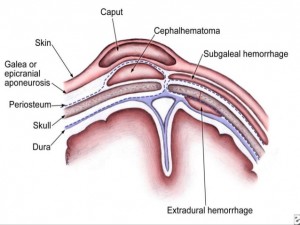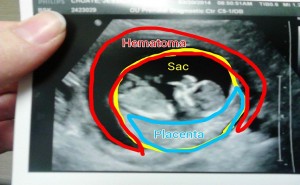
Subgaleal hematoma which is the other name for subgaleal hemorrhage is a condition whereby bleeding occurs in between the skull periosteum and the scalpgalea aponeurosis leading to swelling. It is a very lethal condition in newborns.

Chorionic hematoma (otherwise referred to as chorionic hemorrhage) is the pooling of blood between the chorion, a membrane encompassing the uterine wall and the embryo. With a frequency of about 3 percent in all pregnancies, it is the most frequent sonographic anomaly and the most frequent cause of first trimester bleeding.

Hematoma describes a condition in which blood exists outside of blood vessels. It is actually a common problem that has been experienced by most people at multiple points in their lives.

Hematoma auris (perichondrial hematoma, traumatic auricular hematoma, or cauliflower ear) is a condition that can happen when the outside portion of the ear endures a traumatic blow, a blood clot or a gathering of fluid under the perichondrium. It isolates the cartilage away from the overlying perichondrium supplying its nutrition. This causes it to perish … Continue reading “10 Best Food & Diet Meal Plan for Auricular Hematoma”

Spider veins are dilated capillaries that displays twisted in appearance, resembling spiderweb-like pattern. As you may know, having spider veins is a problem that a lot of men and women can suffer from. The condition is usually harmless but not good-looking.

There are small blood vessels that connect the veins and arteries. They are called capillaries and some may be seen on the surface of the skin. When a capillary is broken, it results to the appearance of thin, red or blue thread that becomes visible on the skin. This is common on body areas that … Continue reading “10 Causes of Broken Capillaries (Spider Veins)”

These are just a few of the causes of blood clots. When left unattended, a thrombosis can be life threatening. It can hinder normal blood circulation which can lead to the lack of blood supply to delicate tissues. When the blood clot suggests harm, proper medical management should not be ignored.








